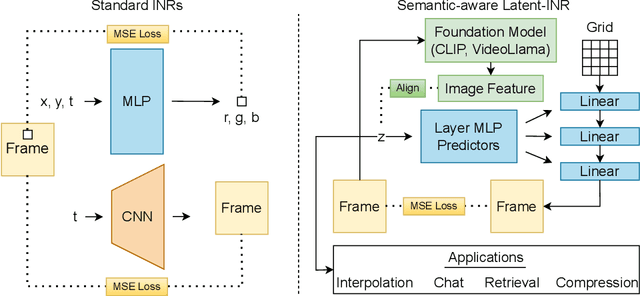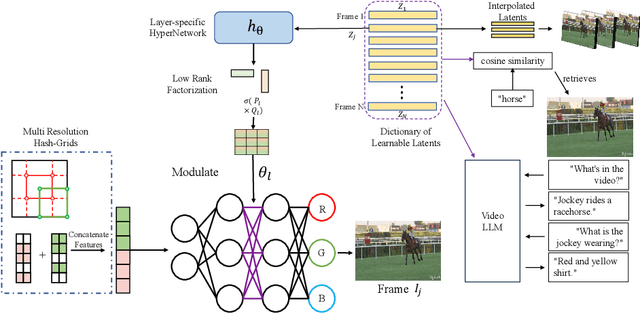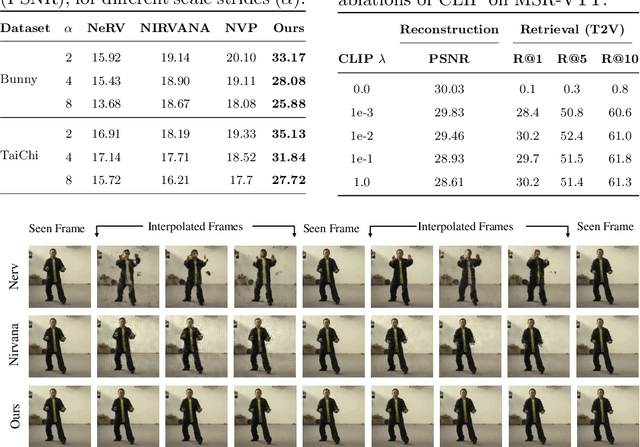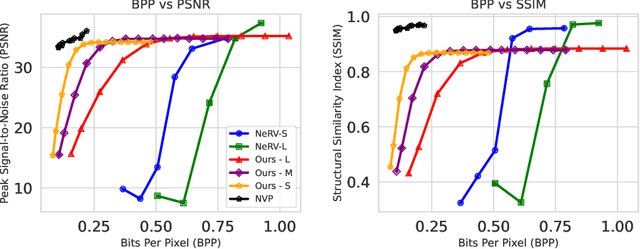Matthew Gwilliam
Towards Multimodal Understanding via Stable Diffusion as a Task-Aware Feature Extractor
Jul 09, 2025Abstract:Recent advances in multimodal large language models (MLLMs) have enabled image-based question-answering capabilities. However, a key limitation is the use of CLIP as the visual encoder; while it can capture coarse global information, it often can miss fine-grained details that are relevant to the input query. To address these shortcomings, this work studies whether pre-trained text-to-image diffusion models can serve as instruction-aware visual encoders. Through an analysis of their internal representations, we find diffusion features are both rich in semantics and can encode strong image-text alignment. Moreover, we find that we can leverage text conditioning to focus the model on regions relevant to the input question. We then investigate how to align these features with large language models and uncover a leakage phenomenon, where the LLM can inadvertently recover information from the original diffusion prompt. We analyze the causes of this leakage and propose a mitigation strategy. Based on these insights, we explore a simple fusion strategy that utilizes both CLIP and conditional diffusion features. We evaluate our approach on both general VQA and specialized MLLM benchmarks, demonstrating the promise of diffusion models for visual understanding, particularly in vision-centric tasks that require spatial and compositional reasoning. Our project page can be found https://vatsalag99.github.io/mustafar/.
Evolutionary Caching to Accelerate Your Off-the-Shelf Diffusion Model
Jun 18, 2025Abstract:Diffusion-based image generation models excel at producing high-quality synthetic content, but suffer from slow and computationally expensive inference. Prior work has attempted to mitigate this by caching and reusing features within diffusion transformers across inference steps. These methods, however, often rely on rigid heuristics that result in limited acceleration or poor generalization across architectures. We propose Evolutionary Caching to Accelerate Diffusion models (ECAD), a genetic algorithm that learns efficient, per-model, caching schedules forming a Pareto frontier, using only a small set of calibration prompts. ECAD requires no modifications to network parameters or reference images. It offers significant inference speedups, enables fine-grained control over the quality-latency trade-off, and adapts seamlessly to different diffusion models. Notably, ECAD's learned schedules can generalize effectively to resolutions and model variants not seen during calibration. We evaluate ECAD on PixArt-alpha, PixArt-Sigma, and FLUX-1.dev using multiple metrics (FID, CLIP, Image Reward) across diverse benchmarks (COCO, MJHQ-30k, PartiPrompts), demonstrating consistent improvements over previous approaches. On PixArt-alpha, ECAD identifies a schedule that outperforms the previous state-of-the-art method by 4.47 COCO FID while increasing inference speedup from 2.35x to 2.58x. Our results establish ECAD as a scalable and generalizable approach for accelerating diffusion inference. Our project website is available at https://aniaggarwal.github.io/ecad and our code is available at https://github.com/aniaggarwal/ecad.
Utilization of Neighbor Information for Image Classification with Different Levels of Supervision
Mar 18, 2025Abstract:We propose to bridge the gap between semi-supervised and unsupervised image recognition with a flexible method that performs well for both generalized category discovery (GCD) and image clustering. Despite the overlap in motivation between these tasks, the methods themselves are restricted to a single task -- GCD methods are reliant on the labeled portion of the data, and deep image clustering methods have no built-in way to leverage the labels efficiently. We connect the two regimes with an innovative approach that Utilizes Neighbor Information for Classification (UNIC) both in the unsupervised (clustering) and semisupervised (GCD) setting. State-of-the-art clustering methods already rely heavily on nearest neighbors. We improve on their results substantially in two parts, first with a sampling and cleaning strategy where we identify accurate positive and negative neighbors, and secondly by finetuning the backbone with clustering losses computed by sampling both types of neighbors. We then adapt this pipeline to GCD by utilizing the labelled images as ground truth neighbors. Our method yields state-of-the-art results for both clustering (+3% ImageNet-100, Imagenet200) and GCD (+0.8% ImageNet-100, +5% CUB, +2% SCars, +4% Aircraft).
NeRF-Aug: Data Augmentation for Robotics with Neural Radiance Fields
Nov 04, 2024



Abstract:Training a policy that can generalize to unknown objects is a long standing challenge within the field of robotics. The performance of a policy often drops significantly in situations where an object in the scene was not seen during training. To solve this problem, we present NeRF-Aug, a novel method that is capable of teaching a policy to interact with objects that are not present in the dataset. This approach differs from existing approaches by leveraging the speed and photorealism of a neural radiance field for augmentation. NeRF- Aug both creates more photorealistic data and runs 3.83 times faster than existing methods. We demonstrate the effectiveness of our method on 4 tasks with 11 novel objects that have no expert demonstration data. We achieve an average 69.1% success rate increase over existing methods. See video results at https://nerf-aug.github.io.
Latent-INR: A Flexible Framework for Implicit Representations of Videos with Discriminative Semantics
Aug 05, 2024



Abstract:Implicit Neural Networks (INRs) have emerged as powerful representations to encode all forms of data, including images, videos, audios, and scenes. With video, many INRs for video have been proposed for the compression task, and recent methods feature significant improvements with respect to encoding time, storage, and reconstruction quality. However, these encoded representations lack semantic meaning, so they cannot be used for any downstream tasks that require such properties, such as retrieval. This can act as a barrier for adoption of video INRs over traditional codecs as they do not offer any significant edge apart from compression. To alleviate this, we propose a flexible framework that decouples the spatial and temporal aspects of the video INR. We accomplish this with a dictionary of per-frame latents that are learned jointly with a set of video specific hypernetworks, such that given a latent, these hypernetworks can predict the INR weights to reconstruct the given frame. This framework not only retains the compression efficiency, but the learned latents can be aligned with features from large vision models, which grants them discriminative properties. We align these latents with CLIP and show good performance for both compression and video retrieval tasks. By aligning with VideoLlama, we are able to perform open-ended chat with our learned latents as the visual inputs. Additionally, the learned latents serve as a proxy for the underlying weights, allowing us perform tasks like video interpolation. These semantic properties and applications, existing simultaneously with ability to perform compression, interpolation, and superresolution properties, are a first in this field of work.
Explaining the Implicit Neural Canvas: Connecting Pixels to Neurons by Tracing their Contributions
Jan 18, 2024Abstract:The many variations of Implicit Neural Representations (INRs), where a neural network is trained as a continuous representation of a signal, have tremendous practical utility for downstream tasks including novel view synthesis, video compression, and image superresolution. Unfortunately, the inner workings of these networks are seriously under-studied. Our work, eXplaining the Implicit Neural Canvas (XINC), is a unified framework for explaining properties of INRs by examining the strength of each neuron's contribution to each output pixel. We call the aggregate of these contribution maps the Implicit Neural Canvas and we use this concept to demonstrate that the INRs which we study learn to ''see'' the frames they represent in surprising ways. For example, INRs tend to have highly distributed representations. While lacking high-level object semantics, they have a significant bias for color and edges, and are almost entirely space-agnostic. We arrive at our conclusions by examining how objects are represented across time in video INRs, using clustering to visualize similar neurons across layers and architectures, and show that this is dominated by motion. These insights demonstrate the general usefulness of our analysis framework. Our project page is available at https://namithap10.github.io/xinc.
Do text-free diffusion models learn discriminative visual representations?
Nov 30, 2023



Abstract:While many unsupervised learning models focus on one family of tasks, either generative or discriminative, we explore the possibility of a unified representation learner: a model which addresses both families of tasks simultaneously. We identify diffusion models, a state-of-the-art method for generative tasks, as a prime candidate. Such models involve training a U-Net to iteratively predict and remove noise, and the resulting model can synthesize high-fidelity, diverse, novel images. We find that the intermediate feature maps of the U-Net are diverse, discriminative feature representations. We propose a novel attention mechanism for pooling feature maps and further leverage this mechanism as DifFormer, a transformer feature fusion of features from different diffusion U-Net blocks and noise steps. We also develop DifFeed, a novel feedback mechanism tailored to diffusion. We find that diffusion models are better than GANs, and, with our fusion and feedback mechanisms, can compete with state-of-the-art unsupervised image representation learning methods for discriminative tasks - image classification with full and semi-supervision, transfer for fine-grained classification, object detection and segmentation, and semantic segmentation. Our project website (https://mgwillia.github.io/diffssl/) and code (https://github.com/soumik-kanad/diffssl) are available publicly.
A Video is Worth 10,000 Words: Training and Benchmarking with Diverse Captions for Better Long Video Retrieval
Nov 30, 2023



Abstract:Existing long video retrieval systems are trained and tested in the paragraph-to-video retrieval regime, where every long video is described by a single long paragraph. This neglects the richness and variety of possible valid descriptions of a video, which could be described in moment-by-moment detail, or in a single phrase summary, or anything in between. To provide a more thorough evaluation of the capabilities of long video retrieval systems, we propose a pipeline that leverages state-of-the-art large language models to carefully generate a diverse set of synthetic captions for long videos. We validate this pipeline's fidelity via rigorous human inspection. We then benchmark a representative set of video language models on these synthetic captions using a few long video datasets, showing that they struggle with the transformed data, especially the shortest captions. We also propose a lightweight fine-tuning method, where we use a contrastive loss to learn a hierarchical embedding loss based on the differing levels of information among the various captions. Our method improves performance both on the downstream paragraph-to-video retrieval task (+1.1% R@1 on ActivityNet), as well as for the various long video retrieval metrics we compute using our synthetic data (+3.6% R@1 for short descriptions on ActivityNet). For data access and other details, please refer to our project website at https://mgwillia.github.io/10k-words.
Diffusion Models Beat GANs on Image Classification
Jul 17, 2023Abstract:While many unsupervised learning models focus on one family of tasks, either generative or discriminative, we explore the possibility of a unified representation learner: a model which uses a single pre-training stage to address both families of tasks simultaneously. We identify diffusion models as a prime candidate. Diffusion models have risen to prominence as a state-of-the-art method for image generation, denoising, inpainting, super-resolution, manipulation, etc. Such models involve training a U-Net to iteratively predict and remove noise, and the resulting model can synthesize high fidelity, diverse, novel images. The U-Net architecture, as a convolution-based architecture, generates a diverse set of feature representations in the form of intermediate feature maps. We present our findings that these embeddings are useful beyond the noise prediction task, as they contain discriminative information and can also be leveraged for classification. We explore optimal methods for extracting and using these embeddings for classification tasks, demonstrating promising results on the ImageNet classification task. We find that with careful feature selection and pooling, diffusion models outperform comparable generative-discriminative methods such as BigBiGAN for classification tasks. We investigate diffusion models in the transfer learning regime, examining their performance on several fine-grained visual classification datasets. We compare these embeddings to those generated by competing architectures and pre-trainings for classification tasks.
Beyond Supervised vs. Unsupervised: Representative Benchmarking and Analysis of Image Representation Learning
Jun 16, 2022



Abstract:By leveraging contrastive learning, clustering, and other pretext tasks, unsupervised methods for learning image representations have reached impressive results on standard benchmarks. The result has been a crowded field - many methods with substantially different implementations yield results that seem nearly identical on popular benchmarks, such as linear evaluation on ImageNet. However, a single result does not tell the whole story. In this paper, we compare methods using performance-based benchmarks such as linear evaluation, nearest neighbor classification, and clustering for several different datasets, demonstrating the lack of a clear front-runner within the current state-of-the-art. In contrast to prior work that performs only supervised vs. unsupervised comparison, we compare several different unsupervised methods against each other. To enrich this comparison, we analyze embeddings with measurements such as uniformity, tolerance, and centered kernel alignment (CKA), and propose two new metrics of our own: nearest neighbor graph similarity and linear prediction overlap. We reveal through our analysis that in isolation, single popular methods should not be treated as though they represent the field as a whole, and that future work ought to consider how to leverage the complimentary nature of these methods. We also leverage CKA to provide a framework to robustly quantify augmentation invariance, and provide a reminder that certain types of invariance will be undesirable for downstream tasks.
 Add to Chrome
Add to Chrome Add to Firefox
Add to Firefox Add to Edge
Add to Edge